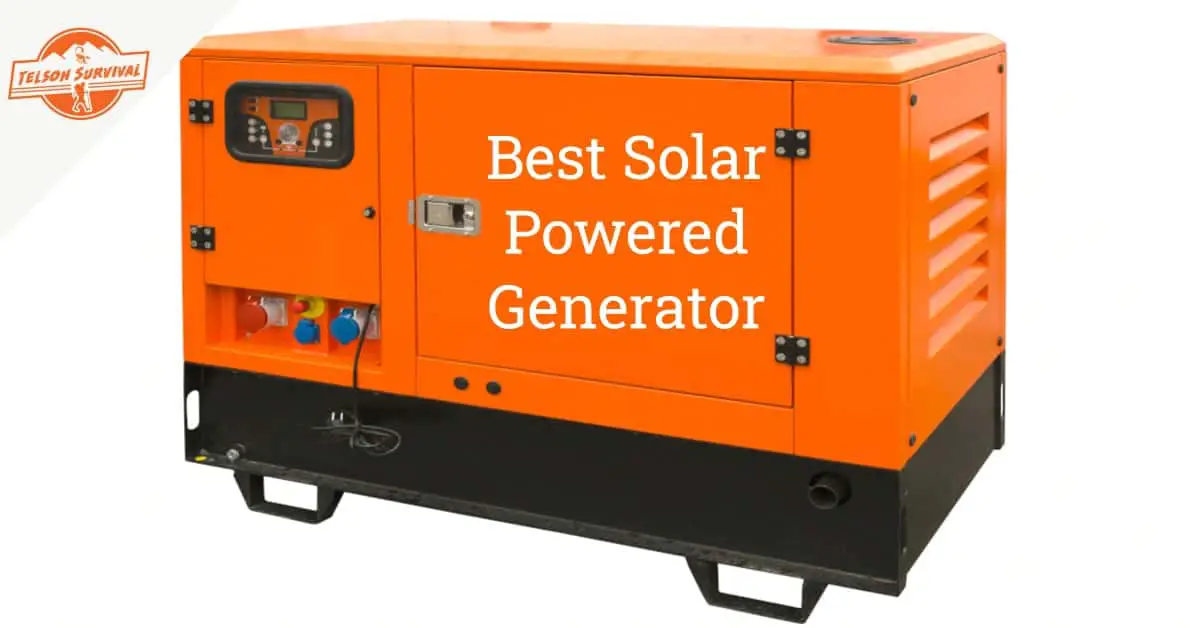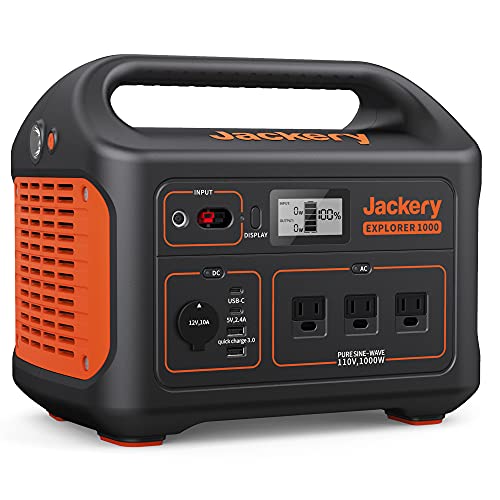Living off the grid has built momentum in the past years. And for anyone opting for an off-grid life, you know there is that one necessity you can’t do without: power.
Whether you need it to charge your communication gadgets or your home appliances such as fridges, cookers, pressing irons, or microwaves, power is going to be something you want to have always. Of course, we are not forgetting that you need it to light your off-grid home.
Because it’s easier to tap the sun’s energy out there off-the-grid, a survival solar generator wouldn’t be a bad option at all. In fact, you should consider it among your top ‘must-have’ off-grid items.
So, what is the best solar generator for off-grid living?
The best solar generator for off-grid living is the one that has an output wattage equivalent to your off-grid power needs. It should have a high battery capacity, a high number of life cycles, a fast charging speed, and multiple output ports among other qualities.
Depending on factors such as having a family or being alone, you’ll need to decide on the size of the solar-powered generator that is best suited for your power needs.
So, before we describe for you the 6 best solar generators for off-grid living, we want to set criteria for choosing based on power needs and generator size.
In a hurry? If you just want to get to our conclusions, here are our top picks and recommendations!
Last update on 2024-12-06 / Affiliate Links / Images from Amazon Product Advertising API
Off-Grid Power Needs vs Generator Size (Deciding what you should go for)
Off-grid power needs are the electricity uses that you’ll need to meet while you are living off the grid.
Generator size is the total amount of watts that it can give to charge devices and appliances at one given time. Hence, the maximum amount of power you’ll need at one given time determines the size of the generator you should go for.
Let’s get practical! For anyone living off the grid there are some basic power needs that you will have:
Basic off-grid power needs (running wattage/surge wattage):
- Charging a cellphone – 10/0
- Charging a laptop – 75/0
- Using an AM/FM radio – 100/0
- Charging a fridge/freezer – 600/2200
- Charging a 27ʺ TV – 500/0
- Using a microwave oven – 750/800
But you might also have some additional medium and high power needs depending on your style of life.
Medium to high power needs (running wattage/surge wattage):
- Using a washing machine – 750/2300
- Running a sump pump – 800/1400
- A low-profile air conditioner (13,500 BTU – Heating) – 1600/2300
- Using an electric water heater – 4000/0
- Using a circular saw – 1500/3000
Considering your off-grid power needs from the above list, you’ll need to determine if you want:
- A low-wattage off-grid solar generator (≤1000 - ˂2000 watts for basic power needs).
- A medium-wattage off-grid solar generator (2000 - ˂3000 watts for basic and some medium power needs).
- A high-wattage off-grid solar generator (≥3000 watts for basic, medium, and high-wattage power needs).
So, think of what your power needs are while you go through the details of our 6 best solar powered generators for off-grid living.
Best 6 Solar Generators for Off-grid Living
To help you determine if you need a low, medium, or high-wattage off-grid power generator, we have categorized our 6 best picks as low-wattage, medium-wattage, or high wattage.
Best overall low-wattage off-grid solar generator: Jackery Explorer 1000
The Jackery Explorer 1000 is a powerhouse just like the manufacturer is a power name in the area of generators. Its 1000/2000 wattage can charge any of the essential devices and appliances during your off-grid bug in. It is also the cheapest generator among our top picks besides being a sturdy and easy to carry power pack.
Jackery Explorer 1000 Key Features:
Portability:
- A 22lbs generator with a 1000watt capacity is extremely light and an easy to carry solar generator kit.
- A strong handle that is continuous with the outer casing.
Battery type and capacity:
- 1000Wh (21.6V, 46.4Ah).
- A Lithium-ion battery which has a longer life when compared to a Lead-acid one.
- 1000 running watt and 2000 surge watt enough to ignite and charge low power home appliances.
- 500 cycles before the battery efficiency is reduced to 80%.
- A built-in Maximum Power Point Tracking (MPPT) charge controller for efficient and quick solar charging.
- 8 hours full recharge with 2x 100w SolarSaga panels or 17 hours with a single panel. 14 hours of 12v carport charging and 7 hours from an AC wall outlet. You can also charge the Explorer 1000 from another generator.
Number and type of outlets:
- 2x USB-C with PD
- 2x USB-A (with QC 3.0 fast-charge port)
- 3x AC outlets (pure sin wave for safe device-charging)
- 1x DC carport
Range of devices/appliances it can charge:
- Cellphones
- Laptops
- Radios
- Coffee makers
- Ice shavers
- TVs
- Drones
- Mini-fridges
- CPAP machines, etc.
Special features:
- LCD screen for monitoring input and output rates, and battery run time status.
- A built-in LED flashlight with a standard and SOS mode.
- BMS safety system.
Last update on 2024-12-06 / Affiliate Links / Images from Amazon Product Advertising API
What you’ll like about the Jackery Explorer 1000:
- Lightweight and compact
- 4 recharge modes
- LCD and safety features
- Universal charging USB-C with PD
- Two-year warranty
What you may not like about the Jackery Explorer 1000:
- Does not support power-hungry basic appliances like hair driers, microwave oven, and induction cooker.
Best Value low-wattage off-grid solar generator: MAXOAK 2400Wh/1000W BLUETTI EB240
When looking for a low power generator for off-grid living, you certainly want one that has a longer life cycle and can charge plenty of the essential home appliances and devices. The MAXOAK 2400Wh/1000W BLUETTI EB240 meets these expectations perfectly and will give you value for your money.
MAXOAK 2400Wh/1000W BLUETTI EB240 Key Features:
Portability:
- A 48.5lbs weight is rather heavy for a portable 1000 watt generator but ok for off-grid living when you don’t have to move it a lot.
- A well-placed strong handle that makes the generator easy to grab and move.
Battery type and capacity:
- 2400Wh (648648mAh/3.7V, 162162mAh/14.8V)
- A long-life inbuilt Lithium-ion battery.
- 1000 running watt and 2400 surge watt, enough to ignite and charge low power home appliances.
- 2500+ cycles before battery efficiency is reduced.
- Built-in MPPT solar charge controller for efficient and quick solar charging.
- Charge time with solar panels depends on the sun and panel wattage. 12 hours AC wall outlet charging.
Number and type of outlets;
- 1x USB-C with PD (45w Max)
- 4x USB-A (5V3A Max)
- 2x AC outlets (pure sin wave for safe device-charging)
- 1x DC 12V carport
Range of devices/appliances it can charge:
- Cellphones
- Laptops
- Radios
- Electric drill
- TVs
- Blenders
- Mini-fridges
- CPAP machines, etc.
Special features:
- LCD screen for monitoring input and output rates, and battery run time status.
- Battery Management System (BMS) for remote monitoring.
No products found.
What you’ll like about the MAXOAK BLUETTI EB240:
- Compact build and durable shell
- 3 recharge modes
- LCD for battery performance monitoring
- MPPT safety charging and BMS remote control
- Universal charging USB-C with PD
- Two-year warranty
What you may not like about the MAXOAK BLUETTI EB240:
- Rather weighty for a portable generator.
- Does not support power-hungry essential appliances like high-power electric kettles, hair driers, coffee makers, and ACs.
Best overall medium-wattage off-grid solar generator: Goal Zero Yeti 3000 Lithium Portable Power Station
The Goal Zero Yeti 3000 portable power generator is another powerhouse capable of charging most of your off-grid appliances. It has an extremely wide range of ports/outlets for charging all your appliances and devices.
The Goal Zero Yeti 3000 Key Features:
Portability:
- A 69lbs could be a lot to move. But the generator is fitted with a cart and a retractable handle for easy moving.
Battery type and capacity:
- 3,075Wh (10.95V, 280.8Ah).
- A Li-ion NMC battery with a longer life when compared to a Lead-acid one.
- 1500 running watt and 3000 surge watt enough to charge a wide range of high-power appliances and devices.
- WiFi Mobile App-enabled to control and monitor your generator from your phone: check battery level and input/output power, update firmware, and turn outlets/ports on and off.
- 500 cycles before the battery efficiency can be reduced to 80%.
- A built-in MPPT charge controller for a faster and efficient recharge speed (up to 40% faster).
- 20-60 hours of solar charging with the Yeti 200W boulder. Also charges fully in 10 hours from a wall outlet. You can charge it from the 12V carport only with a Goal Zero Yeti Lithium 12V car charging cable.
Number and type of outlets:
- 1x USB-C PD output port
- 1x USB-C port
- 1x USB-A port
- 6x AC outlets (pure sin wave for safe device-charging)
- 6mm regulated port (12V, up to 10A (120W max)
- 12V regulated carport (12V, up to 13A (160W max)
- 12V regulated High Power Port (12V, up to 30A (240W max)
- 120V AC pure sine wave outlet (120VAC 60Hz, 12.5A)
Range of devices/appliances it can charge:
- Light bulbs
- Cellphones
- Laptops
- Radios
- 42ʺ TVs
- Pellet grill
- CPAP machines
- Fridges, etc.
Special features:
- LCD screen for monitoring input/output rates and battery run time status.
- Expansion Module port to be used with Goal Zero expansion modules only.
No products found.
What you’ll like about the Goal Zero Yeti 3000:
- 3 input options
- Plenty of output ports
- Cart and retractable handle for easier movement.
- Two-year warranty
What you may not like about the Goal Zero Yeti 3000:
- Slow recharging.
- Quite pricey.
Best value medium-wattage off-grid solar generator: ECOFLOW Portable Power Station EFDELTA
The ECOFLOW Portable Power Station EFDELTA is another great choice medium-wattage solar generator for anyone looking to charge essential devices and appliances that have a high surge watt.
The power station has an 1800 running watt and a 3300 surge watt plus a wide range of charging outlets and safety features which give value for your hard-earned money.
The ECOFLOW EFDELTA Key Features:
Portability:
- A 30.9lbs weight is easy to handle with the ECOLOW’s handles on both sides.
Battery type and capacity:
- 1260Wh (350Ah, 3.7V).
- A Lithium-ion battery with a longer life when compared to a Lead-acid battery.
- 1800 running watt and 3300 surge watt, enough to ignite any high-wattage appliance and charge a wide range of home appliances and devices.
- 800 cycles before the battery efficiency can be reduced to 60%.
- A built-in MPPT charge controller for faster and efficient recharge speed.
- Compatible with any 400W solar input on the market and charges to full capacity in 4 hours. Can also charge with a 12/24V (130W Max) carport for 10-12 hours or another pure sine wave generator for 1.6 hours.
Number and type of outlets:
- 2x USB-C
- 4x USB-A
- 6x AC outlets (pure sin wave for safe device-charging)
- 1x 12V carport
Range of devices/appliances it can charge:
- Cellphones
- Laptops
- Radios
- TVs
- Fridges
- Coffee machines
- Microwave ovens
- CPAP machines
- Drills and saws
Special features:
- An easy-to-read LCD screen for monitoring input/output rates and battery run time status.
- Overload auto protection when the input exceeds 20A.
- Extreme temperature protection for both input and output ports when temperatures are high (45°C) or low (-20°C).
Last update on 2024-12-07 / Affiliate Links / Images from Amazon Product Advertising API
What you’ll like about the ECOFLOW EFDELTA:
- Dual-handle for easy carrying
- 3 input options
- 13 output ports
- Easy-to-read LCD
- Charges a wide range of devices/appliances
- Multiple auto-protect features
- Two-year warranty
What you may not like about the ECOFLOW EFDELTA:
Best overall high-wattage off-grid solar generator The Point Zero Energy Titan
If you want an off-grid generator option that is not going to limit your power needs, the Point Zero Energy Titan is definitely what you should go for. This power giant will give you 3000 running watts and a whopping 6000 surge watts.
The Point Zero Energy Titan Key Features:
Portability:
- A 33lbs weight for such a high-wattage generator is great though the handle may not be high-quality.
Battery type and capacity:
- 2000Wh (74Ah).
- A Lithium-ion removable battery that can be expanded in capacity with another Titan Lithium-ion battery or a Lead-acid battery of up to 24V.
- 3000 running watts and 6000 surge watts enough to ignite any appliance you can think of.
- 2000 cycles.
- 2 built-in MPPT charge controllers for an optimal recharge rate.
- The Point Zero Titan is built with a 1,000W solar panel charge rate (even though it could charge faster) to prevent battery damage. That would mean 2 hours of recharge time with solar. The battery also charges in 4 hours from an AC wall outlet.
Number and type of outlets:
- 6x smart USB
- 2x USB-C
- 4x 12V ports regulated at 13.8V (20A Max)
Range of devices/appliances it can charge:
- Literally, everything you need to power in and out of your off-grid home (cellphones, laptops, radios, TVs, fridges, coffee machines, blender, washing machine, drills and saws, sump pumps, etc).
Special features:
- An LCD screen that tells you the nominal battery voltage, the number of amps and wattage going in and out, and how long you can run a specific load.
- 2000W pure sine wave inverter for safe charging of all your devices.
What you’ll like about the Point Zero Energy Titan:
- Extremely high wattage, you can charge anything in your off-grid home.
- Extremely fast charging
- 12 output ports
- Detachable and expandable battery
- 2000 cycles!
- Two-year warranty
What you may not like about the Point Zero Energy Titan:
- Generator handle is not really sturdy.
- High-wattage inverter consumes a small amount of wattage when the generator is idle.
- For an off-grid generator, you’ll literary break your bank!
Best value high-wattage off-grid solar generator: Goal Zero Yeti 1500X Portable Power Station
The Goal Zero Yeti 1500X is a high-wattage solar generator that will give you plenty of power to charge any appliance or device in your off-grid bug out. With a 3500 surge watt, it will withstand most power-hungry appliances.
The Goal Zero Yeti 1500X Key Features:
Portability:
- 43lbs weight may be difficult to manage with the provided handles.
Battery type and capacity:
- 1516Wh (10.8V, 140.4Ah).
- A Li-ion NMC battery with a longer life when compared to a Lead-acid one.
- 2000 running watt and 3500 surge watt, enough for power-hungry appliances. It charges a wide range of basic home appliances/devices.
- 500 life cycles before the battery efficiency can be reduced to 80%.
- A built-in MPPT charge controller for faster and efficient recharge rate.
- 18-36 hours of solar charging with the Yeti 100W boulder. Also charges fully in 14 hours from a wall outlet. It can be charged from a 12V car port only with a Goal Zero Yeti Lithium 12V car charging cable.
Number and type of outlets:
- 1x USB-C PD input/output port
- 1x USB-C port
- 2x USB-A port
- 6x AC outlets (pure sin wave for safe device-charging)
- 6mm regulated port (12V, up to 10A (120W max)
- 12V regulated carport (12V, up to 13A (160W max)
- 12V regulated High Power Port (12V, up to 30A (360W max)
- 120V AC pure sine wave outlet (120VAC 60Hz, 16.5A)
Range of devices/appliances it can charge:
- Light bulbs
- Cellphones
- Laptops
- CPAP machines
- Radios
- Refrigerators
- TVs
- Pellet grills, etc.
Special features:
- LCD screen for monitoring battery run time and status input/output rates.
- Expansion Module port to be used with Goal Zero expansion modules only.
Last update on 2024-12-07 / Affiliate Links / Images from Amazon Product Advertising API
What you’ll like about the Goal Zero Yeti 1500X:
- 3 input options
- Plenty of output options
- Charges a wide range of high-wattage appliances
- Two-year warranty
What you may not like about the Goal Zero Yeti 1500X:
- Heavy to move with the attached handles.
- Slow recharging.
Best Solar Generator Buying Guide (Comparing Our Top Picks)
When thinking about buying a solar generator kit for off-grid living it’s important to know that these power packs have many benefits (and drawbacks) when compared among themselves or to other generators. Read about solar generator pros and cons in our comprehensive generator types for off-grid living article.
So, not every solar generator may be the best one for your off-grid power needs. We will make a solar generator comparison for our top picks as we tell you the features you should look for.
To decide on the best solar generator for off-grid living, ask yourself these 5 questions about their efficiency-features.
Q1: What is the battery capacity of a solar generator?
Generator battery capacity is an indication of the amount of electric current that the battery can hold/store. It is measured in Watt-hours (Wh), which means the higher the battery capacity the longer the battery will last.
From our best solar generator for off-grid living suggestions:
When buying a generator, look for one with reliable battery capacity and can store power for long. This will help you meet all your power needs while there is no sun.
From our suggestions, the Goal Zero Yeti 3000 has the highest battery capacity (3075Wh) while the Jackery Explorer 1000 has the lowest (1000Wh).
Q2: How much power do I need from a solar generator?
If you are going to live off the grid or are already living there, you might want a generator that meets all your power needs while you wait to install a larger power source or when you have power outages and need emergency solar lighting.
It could also be that you need emergency backup power when making maintenance and repair on your main system. Someone may also decide that the generator is their consistent source of power.
Whichever is your case, the amount of power you’ll need at one given time should determine your generator size (see the previous section on “Off-grid Power Needs vs Generator Size”).
If you are going to power low-wattage appliances/devices, a low power generator will suffice. If you need to power power-hungry appliances, a high-wattage generator is required.
Remember that high-power appliances usually need a high surge watt as compared to low-power devices.
From our best solar generator for off-grid living suggestions:
Go for the Jackery Explorer 1000 or the MAXOAK 2400Wh/1000W BLUETTI EB240 if you need to power low-wattage devices/appliances.
Instead, choose one of the medium-power or high-power options if you need to charge power-hungry appliances.
For example, if you’ll be using high surge power appliances such as a washing machine (2300), air conditioner (2300), and circular saw (3000), you definitely need to choose between the Point Zero Energy Titan (6000), and the Goal Zero Yeti 1500x (3500).
Q3: What type of battery does a solar generator have?
Generator batteries are either Lithium-ion or Lead-acid. Considering if they are replaceable is also an important factor to note as we’ll tell you in the next question.
Lithium-ion batteries are more common and also have a longer lifespan. They are lightweight and smaller in size but have a higher price tag.
Lead-acid batteries have similar features as car batteries. They are less expensive but weightier and with a shorter lifespan.
From our best solar generator for off-grid living suggestions:
Our 6 best solar generators for off-grid living all come with Lithium batteries, so they will give you quality for your money. The Point Zero Energy Titan, however, gives you the possibility of expanding battery capacity with a Lead-acid option.
Q4: What is a solar generator battery life cycle?
A generator battery’s life cycle is the number of times it can be charged and drained without reducing its efficiency. Most generator batteries have around 500-800 life cycles while the batteries of the most efficient generators have a life cycle of around 2000.
Once the lifecycle is reduced, most generators will drop to 80% efficiency and keep reducing from there. Others like the ECOFLOW Portable Power Station EFDELTA may reduce straight to 60%.
Some generators will allow you to replace batteries when their efficiency is reduced. Others have an inbuilt irreplaceable battery.
From our best solar generator for off-grid living suggestions:
The MAXOAK 2400Wh/1000W BLUETTI EB240 has the highest number life cycle (2500+). So, if you want a generator that gives you 100% efficiency for the longest time, you should go for it. The others have life cycles between 500 and 2000.
The best choice from our top picks when it comes to battery replacement is the Point Zero Energy Titan which can also be increased in capacity.
Q5: What is a solar generator battery recharge rate?
Solar generator recharge rate can be determined by the number of watts that the battery inputs from the power source (solar panels, AC wall outlet, or 12V carport). This then translates to the number of hours that the battery takes before being fully recharged.
From our best solar generator for off-grid living suggestions:
Despite its high wattage capacity, the Point Zero Energy Titan has the fastest recharge rate (2 hours from a 1000W solar panel and 4 hours from an AC wall plug). The Goal Zero Yeti generators have the slowest recharge speed.
7 Other solar generator buying considerations
A few other factors are also worth bearing in mind when buying a solar powered generator for off-grid living:
- Charge controllers: Solar generators with MPPT charge controllers have faster and efficient input charging.
- Pure sine wave inverter: a pure sine wave output protects delicate appliances/devices from damage.
- Solar panel capacity: Solar generators have a Max wattage input which should determine the capacity of the charging solar panel(s).
- Solar generator weight: when it comes to the best generator for emergency preparedness, weight may matter a lot. But generator weight may not really matter when you are living off the grid. Nonetheless, it’s always better if your solar generator is light enough to be moved with ease or has a portability feature such as a cart or wheels.
- Battery expandability: a solar generator with the possibility of connecting other batteries to expand capacity is a plus in case you’ll need it.
- Output type and number: having a variety of output ports gives you the possibility of using your generator to recharge a wider variety of appliances/devices. USB ports, AC ports as well as DC ports will all come in handy.
- LCD Screen: this is a given for most generators today. An LCD screen lets you read your solar generator’s input/output wattages status as well as the status of the run time. All these are key in monitoring and managing your generator usage.
Best Solar Generator for Off-grid Living FAQS
Away from the off-grid solar generator buying questions, some general questions on solar generators and off-grid living may serve to complete your solar-generator knowledge.
Can a solar generator power a house?
It depends. If you want solar electricity to power your entire home, you’ll need an extremely high-wattage solar generator that can support high surge wattages from a number of home appliances like air conditioners.
Such a generator would have to be installed into the main power line. Off-the-grid solar system packages may work in a similar way. Instead, portable solar generators can be used to charge home appliances directly by manually plugging them into the output ports.
What size solar generator do I need to run a refrigerator?
A standard size refrigerator/freezer needs 600 running watts and 2200 surge watts. You’ll need a generator with 2200+ surge watts since it is advisable to always go for a generator whose surge watts are higher than the surge watts of any of the appliances it will be charging.
Before assuming this formula works for your generator, check your generator’s surge watts (from the user manual or the sticker on the generator or call the manufacturer) and go for a solar generator with a higher surge watt than that of your generator.
What is the best solar generator for home use?
The best solar generator for home use is the one that will meet the power needs for the home. To determine your home’s power needs you should sum the running watts of all the appliances you want to power plus the highest surge watt among the appliances.
The best solar generator for home use should also have key efficiency features such as auto-switch off during an overload, an LCD for monitoring generator status, and multiple output ports.
Best Solar Generator for Off-grid Living Summary
Solar generators can be an optimal choice for your off-grid power needs. But to be sure that is the case, you’ll need to choose the best solar generator for off-grid living.
The best solar generator for your off-grid life is the one that meets all your power needs. It should also have some efficiency qualities such as fast recharging, high battery capacity, and multiple output outlets.
For off-grid living where you are not connected to public utilities, a 1000-watt solar generator would be a low-wattage option enough to charge your most essential devices/appliances.
Medium-wattage solar generators will have a wattage of 2000-3000 while high-wattage off-grid solar generators have a wattage higher than 3000.
Consider other factors like generator safety features, pure sine wave inverters, solar panel capacity, and battery capacity expandability when choosing an off-grid solar generator to ensure you’re really buying the best.













